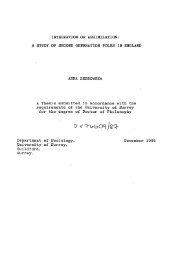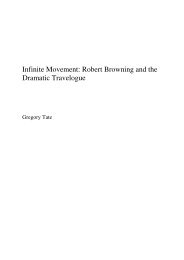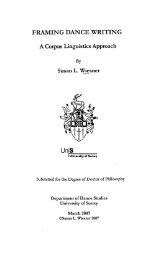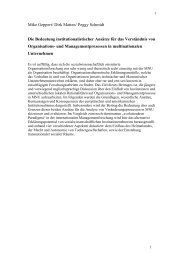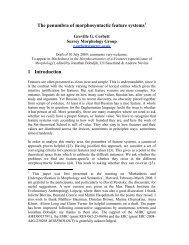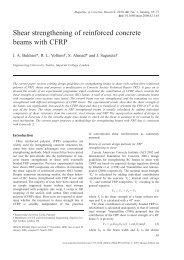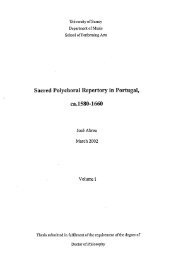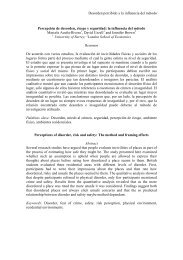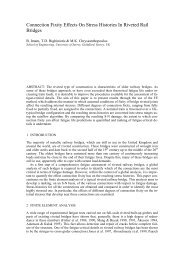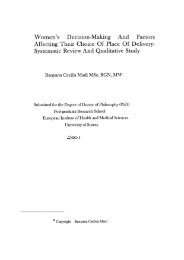Introduction: Global Alliances in Tourism and Hospitality Management
Introduction: Global Alliances in Tourism and Hospitality Management
Introduction: Global Alliances in Tourism and Hospitality Management
Create successful ePaper yourself
Turn your PDF publications into a flip-book with our unique Google optimized e-Paper software.
<strong>Introduction</strong>:<br />
<strong>Global</strong> <strong>Alliances</strong> <strong>in</strong> <strong>Tourism</strong><br />
<strong>and</strong> <strong>Hospitality</strong> <strong>Management</strong><br />
John C. Crotts<br />
Dimitrios Buhalis<br />
Roger March<br />
INTRODUCTION<br />
The development <strong>and</strong> management of alliances is a critical strategic skill<br />
<strong>in</strong> hospitality <strong>and</strong> tourism. Very little can happen <strong>in</strong> these sectors without<br />
multiple firms work<strong>in</strong>g collaboratively with one another to serve the consumer.<br />
All over the world companies are enter<strong>in</strong>g <strong>in</strong>to alliances (see Table 1). However,<br />
research <strong>in</strong> this <strong>and</strong> other sectors suggest that most will fail leav<strong>in</strong>g both<br />
partners sadder but hopefully the wiser. In this volume we will exam<strong>in</strong>e the<br />
basic elements of successful alliances-as well as those not so successful-<strong>and</strong><br />
provide <strong>in</strong>sights as to how to get ready to partner.<br />
The words strategic alliances, relationships, strategic partnerships, <strong>and</strong><br />
jo<strong>in</strong>t ventures all describe the com<strong>in</strong>g together of two firms <strong>in</strong>to a deliberate<br />
association that has some synergistic strategic value. They may assume the<br />
form of: (a) a buyer-seller relationship as <strong>in</strong> the case of an association meet<strong>in</strong>g<br />
planner <strong>and</strong> a conference hotel, a restaurant <strong>and</strong> a s<strong>in</strong>gle-source wholesale<br />
John C. Crotts is Associate Professor <strong>and</strong> Director, <strong>Hospitality</strong> <strong>and</strong> <strong>Tourism</strong><br />
<strong>Management</strong> Program, Department of Market<strong>in</strong>g <strong>and</strong> <strong>Management</strong>, School of Bus<strong>in</strong>ess<br />
<strong>and</strong> Economics, College of Charleston, Charleston, SC.<br />
Dimitrios Buhalis is Senior Lecturer <strong>in</strong> <strong>Tourism</strong>, University of Westm<strong>in</strong>ster,<br />
London, Engl<strong>and</strong>.<br />
Roger March is affiliated with the School of Market<strong>in</strong>g, University of New South<br />
Wales, Sydney, Australia.<br />
[Haworth co-<strong>in</strong>dex<strong>in</strong>g entry note]: ‘‘<strong>Introduction</strong>: <strong>Global</strong> <strong>Alliances</strong> <strong>in</strong> <strong>Tourism</strong> <strong>and</strong> <strong>Hospitality</strong> <strong>Management</strong>.’’<br />
Crotts, John C., Dimitrios Buhalis, <strong>and</strong> Roger March. Co-published simultaneously <strong>in</strong> International<br />
Journal of <strong>Hospitality</strong> & <strong>Tourism</strong> Adm<strong>in</strong>istration (The Haworth Press, Inc.) Vol. 1, No. 1, 2000, pp. 1-10;<br />
<strong>and</strong>: <strong>Global</strong> <strong>Alliances</strong> <strong>in</strong> <strong>Tourism</strong> <strong>and</strong> <strong>Hospitality</strong> <strong>Management</strong> (ed: John C. Crotts, Dimitrios Buhalis, <strong>and</strong><br />
Roger March) The Haworth Press, Inc., 2000, pp. 1-10. S<strong>in</strong>gle or multiple copies of this article are available<br />
for a fee from The Haworth Document Delivery Service [1-800-342-9678, 9:00 a.m. - 5:00 p.m. (EST). E-mail<br />
address: get<strong>in</strong>fo@haworthpress<strong>in</strong>c.com].<br />
E 2000 by The Haworth Press, Inc. All rights reserved. 1
2 GLOBAL ALLIANCES IN TOURISM AND HOSPITALITY MANAGEMENT<br />
TABLE 1. Announcements of <strong>Alliances</strong> <strong>in</strong> the Travel Trade Press<br />
United, Lufthansa, Air Canada, SAS <strong>and</strong> THAI create Star Alliance<br />
to br<strong>in</strong>g benefits for airl<strong>in</strong>e customers<br />
Northwest <strong>and</strong> Cont<strong>in</strong>ental airl<strong>in</strong>es form strategic alliance<br />
to strengthen their position <strong>in</strong> a competitive global marketplace.<br />
United-Delta consider similar move.<br />
The Thomas Cook Group Ltd. forms a jo<strong>in</strong>t market<strong>in</strong>g alliance<br />
with the American Automobile Association<br />
The SABRE Group, ABACUS International Hold<strong>in</strong>gs Create Jo<strong>in</strong>t<br />
Venture to Serve Asia-Pacific Travel Market: 7,300 Travel Agencies<br />
to Use Customized SABRE System<br />
ITT Sheraton <strong>and</strong> Visa U.S.A. Establish Market<strong>in</strong>g Relationship<br />
That Benefits Travelers<br />
WorldRes Forms Strategic Alliance with the Pembridge Group<br />
Biztravel.com To Partner With EventSource; Alliance To Provide<br />
First Integrated Event Plann<strong>in</strong>g <strong>and</strong> Bus<strong>in</strong>ess Travel Solution<br />
Galileo International Teams Up with ITN<br />
for Corporate Travel Solution<br />
WorldRes <strong>and</strong> Wizcom Announce Internet Alliance<br />
Equity Inns Enters Into Strategic Alliance<br />
With U.S. Franchise Systems<br />
California Cultural <strong>Tourism</strong> Coalition Debuts Multi-Million<br />
Dollar Promotional Campaign ‘California, Culture’s Edge’<br />
Source: Hotel.Onl<strong>in</strong>e <strong>Hospitality</strong> News Headl<strong>in</strong>es<br />
supplier; (b) a supplier-distributor relationship as <strong>in</strong> the case of airl<strong>in</strong>es <strong>and</strong><br />
retail travel agencies; (c) an alliance between two or more suppliers like the<br />
United-Lufthansa-Air Canada-SAS alliance; <strong>and</strong> (d) a jo<strong>in</strong>t venture between<br />
two companies like The SABRE Group <strong>and</strong> ABACUS International jo<strong>in</strong>t<br />
venture. All of these alliances share a sufficient amount of common elements<br />
that they can be treated as a basic unit of analysis. In the current competitive<br />
environment where firms strive to become world class competitors, the motivation<br />
to partner, <strong>in</strong> one or all of these forms, is great.<br />
S<strong>in</strong>ce Thomas Cook packaged the first tour <strong>in</strong> 1841, hospitality <strong>and</strong> tourism<br />
enterprises have forged long term alliances with one another. Why are<br />
these alliances different today? To illustrate, consider the supplier-distributor<br />
relationship between airl<strong>in</strong>es <strong>and</strong> retail travel agents. Long before airl<strong>in</strong>e
<strong>Introduction</strong> 3<br />
deregulation, the relationship between the first airl<strong>in</strong>es <strong>and</strong> travel agencies<br />
grew organically over time <strong>in</strong> response to consumer needs <strong>and</strong> the f<strong>in</strong>ancial<br />
<strong>and</strong> technical satisfaction by these suppliers <strong>and</strong> <strong>in</strong>termediaries work<strong>in</strong>g with<br />
each other. The firms <strong>in</strong>volved <strong>in</strong> the relationship meshed as complementary<br />
components that achieved a level of satisfaction for all firms <strong>in</strong>volved. Over<br />
time these alliances evolved <strong>in</strong>to a distribution system supported by the prompt<br />
payment of commissions <strong>in</strong> exchange for customers that supported <strong>and</strong> enhanced<br />
the relationship. Today, however, the need to cut costs <strong>and</strong> <strong>in</strong>crease<br />
profits have led to most airl<strong>in</strong>es reduc<strong>in</strong>g <strong>and</strong> capp<strong>in</strong>g commissions at levels<br />
where most travel agencies cannot susta<strong>in</strong> themselves. Though sell<strong>in</strong>g directly<br />
to the customer appears to be a sound f<strong>in</strong>ancial strategy for airl<strong>in</strong>es, one must<br />
wonder what the ultimate impact will be on the airl<strong>in</strong>es who have created such<br />
adversarial conditions with travel agencies s<strong>in</strong>ce choice is someth<strong>in</strong>g consumers<br />
generally want more, not less, of <strong>and</strong> most will cont<strong>in</strong>ue to prefer purchas<strong>in</strong>g<br />
airl<strong>in</strong>e tickets through an <strong>in</strong>termediary. Great strategic advantages can be<br />
obta<strong>in</strong>ed by airl<strong>in</strong>es who break ranks with the major airl<strong>in</strong>es <strong>and</strong> seek closer<br />
cooperative relationships with retail travel agents.<br />
Today, alliances are <strong>in</strong>strumental to a corporate strategy (Kotler, Bowen <strong>and</strong><br />
Maken 1998), but most are not entered <strong>in</strong>to nor ma<strong>in</strong>ta<strong>in</strong>ed with careful<br />
thought. Many reflect a ‘‘ready-fire-aim’’ approach to relationship development<br />
where firms create alliances to meet strategic goals without implement<strong>in</strong>g<br />
the appropriate mechanisms to assure relationship survival. In addition, we see<br />
examples of short-term power imbalances where one firm exerts power over<br />
another that underm<strong>in</strong>es trust <strong>and</strong> threatens the dissolution of the alliance.<br />
To achieve world class competitive levels a firm must <strong>in</strong>crease its effectiveness<br />
to reach, serve <strong>and</strong> satisfy its target markets, while at the same time<br />
lower costs. Lead<strong>in</strong>g firms have found that one cannot achieve the tw<strong>in</strong> goals<br />
by go<strong>in</strong>g-it-alone. Large conglomerates seldom are susta<strong>in</strong>able over time as<br />
evidenced by the break-up of American Express <strong>in</strong> the 1980s <strong>and</strong> the downsiz<strong>in</strong>g<br />
of JAL <strong>in</strong> the late 1990s. Through alliances, firms can ga<strong>in</strong> market<br />
dom<strong>in</strong>ance <strong>and</strong> global reach that are beyond the resources of one firm to<br />
create <strong>and</strong> susta<strong>in</strong> alone.<br />
CREATING A PARTNERSHIP<br />
There are five critical questions that need to be addressed before creat<strong>in</strong>g a<br />
partnership. They are:<br />
1. Do we want to partner?<br />
2. Do we have an ability to partner?<br />
3. With whom do we partner?<br />
4. How do we partner?<br />
5. How do we susta<strong>in</strong> <strong>and</strong> renew a partnership over time?
4 GLOBAL ALLIANCES IN TOURISM AND HOSPITALITY MANAGEMENT<br />
Do We Want to Partner?<br />
In answer<strong>in</strong>g the first question one needs to assess the degree to which<br />
partner<strong>in</strong>g can play a role <strong>in</strong> help<strong>in</strong>g the firm obta<strong>in</strong> strategic advantages <strong>in</strong><br />
the marketplace. Strategic advantage is derived from a partnership where a<br />
jo<strong>in</strong>t action can achieve someth<strong>in</strong>g the customer will value at a reduced risk<br />
for all firms <strong>in</strong>volved. Technological <strong>in</strong>novations, <strong>in</strong>creased service <strong>and</strong> market<br />
coverage at less costs appear to be the reasons why many travel <strong>and</strong><br />
tourism firms agree to partner. However, partner<strong>in</strong>g is often a competitive<br />
response because others <strong>in</strong> the <strong>in</strong>dustry are ga<strong>in</strong><strong>in</strong>g strategic advantages<br />
through their own partnerships <strong>and</strong> the other firms feel compelled to counter<br />
with alliances of their own.<br />
Do We Have an Ability to Partner?<br />
To be a good partner one must be ready to partner. Be<strong>in</strong>g a good partner<br />
often requires a cultural change <strong>in</strong> an organization <strong>and</strong> its people. This question<br />
requires that a firm perform an <strong>in</strong>ternal audit of its own ability to be a<br />
good partner. Reputation, performance capabilities, w<strong>in</strong>-w<strong>in</strong> orientation <strong>and</strong><br />
the ability to create <strong>and</strong> susta<strong>in</strong> trust is central to attract<strong>in</strong>g the right partner.<br />
Often we f<strong>in</strong>d firms that have a difficult time work<strong>in</strong>g collaboratively with<strong>in</strong><br />
their own organization, let alone with an outside firm. Individuals need to<br />
underst<strong>and</strong> why external alliances are important, how to support the external<br />
relationship, <strong>and</strong> be evaluated <strong>and</strong> rewarded accord<strong>in</strong>gly.<br />
With Whom Do We Partner?<br />
The first step <strong>in</strong> select<strong>in</strong>g a partner is to select the areas where a potential<br />
partner will have a positive impact on one’s bus<strong>in</strong>ess. Wilson (1996) provides<br />
two methods useful for categoriz<strong>in</strong>g potential partners. In Figure 1, the potential<br />
value of a partner (vertical axis) is accessed on a multi-dimensional scale<br />
<strong>in</strong>clud<strong>in</strong>g such items as impact on profits, market penetration, market coverage<br />
<strong>and</strong> technological <strong>in</strong>novations. Each firm must develop its own set of<br />
measures with which to def<strong>in</strong>e a partner’s potential value. The horizontal axis<br />
is the ability to partner with the other firm. Ability to partner is the flip-side of<br />
the previous question <strong>in</strong> that one should evaluate the ability of the other firm<br />
to partner successfully. Low cultural fit, lack of trust <strong>and</strong> poor communication<br />
can all be impediments to achiev<strong>in</strong>g a successful relationship. Firms <strong>in</strong><br />
the upper right h<strong>and</strong> quadrant are both important to a firm’s long term success<br />
<strong>and</strong> possess a high ability to partner successfully. The more difficult situation<br />
is exhibited by those firms <strong>in</strong> the quadrant that are high <strong>in</strong> importance but have<br />
a low ability to partner. Here a firm needs to ascerta<strong>in</strong> if one can overcome
High<br />
Ability to<br />
Add Value<br />
Low<br />
<strong>Introduction</strong> 5<br />
FIGURE 1. Partner Selection Criteria<br />
Low Ability to Partner High<br />
the root causes of its counterpart’s low ability to partner. In some <strong>in</strong>stances it<br />
may be impossible to overcome these differences.<br />
Another more market oriented method of sort<strong>in</strong>g potential partners purported<br />
by Wilson (1996) is described <strong>in</strong> Figure 2. The ability to add value<br />
addresses the issue previously discussed on build<strong>in</strong>g strategic advantage. In<br />
assess<strong>in</strong>g a potential partner’s ability to lower your firm’s operat<strong>in</strong>g risk, one<br />
should consider such items as consistent high quality, reliable performance<br />
<strong>and</strong> trust <strong>in</strong> the other firm not to act opportunistically.<br />
How Do We Partner?<br />
A number of scholars have developed reasonably well-supported models<br />
of successful buyer-seller alliances (Dwyer, Schurr <strong>and</strong> Oh 1987, Heide <strong>and</strong><br />
George 1990, Morgan <strong>and</strong> Hunt 1994, Crotts <strong>and</strong> Wilson 1995, Wilson<br />
1996). Although they vary <strong>in</strong> specific details, they all use similar constructs<br />
that <strong>in</strong>fluence the success or failure <strong>in</strong> a relationship. Johanson, Lars <strong>and</strong><br />
Nazeem’s (1991) def<strong>in</strong>ition of a relationship is useful <strong>in</strong> that it applies the<br />
elements of these conceptual models. For Johanson et al. ‘‘a strategic alliance<br />
is def<strong>in</strong>ed as an <strong>in</strong>ter-organizational relationship where the partners make<br />
substantial <strong>in</strong>vestments <strong>in</strong> time, effort <strong>and</strong> resources <strong>in</strong> develop<strong>in</strong>g long-term<br />
collaborative effort <strong>and</strong> common orientation towards meet<strong>in</strong>g <strong>in</strong>dividual <strong>and</strong><br />
mutual goals.’’ Inherent <strong>in</strong> this def<strong>in</strong>ition <strong>and</strong> operationalized <strong>in</strong> nearly all the<br />
success models of relationship development are:
6 GLOBAL ALLIANCES IN TOURISM AND HOSPITALITY MANAGEMENT<br />
S Reputation<br />
S Performance Capabilities<br />
S Goal Compatibility<br />
S Trust<br />
S Strategic Advantage<br />
S Amount of Adaptations/Non-Retrievable Investments<br />
S Communication<br />
S Cooperation<br />
S Social Bond<strong>in</strong>g<br />
For reasons of parsimony, the reader is referred to Crotts <strong>and</strong> Wilson<br />
(1995) or Crotts, Aziz <strong>and</strong> Raschid (1998) for operational def<strong>in</strong>itions of each<br />
of these constructs. The po<strong>in</strong>t is that these are variables that must be successfully<br />
communicated or evoked <strong>in</strong> order to attract <strong>and</strong> reta<strong>in</strong> the <strong>in</strong>terest of a<br />
prospective partner <strong>in</strong> a jo<strong>in</strong>t alliance.<br />
How Does a Partnership Susta<strong>in</strong> <strong>and</strong> Renew Itself over Time?<br />
The Ch<strong>in</strong>ese symbol for crisis is the comb<strong>in</strong>ation of two characters. One<br />
character depicts danger <strong>and</strong> the other depicts opportunity. This is a perfect<br />
description of our current underst<strong>and</strong><strong>in</strong>g of relationship development. Great<br />
opportunities exist for firms that form strong synergistic alliances to grow<br />
<strong>and</strong> flourish. At the same time there is great danger if the relationship fails as<br />
a firm can loose competitive position as well as a great deal of money.<br />
High<br />
Ability to<br />
Add Value<br />
FIGURE 2. Evaluat<strong>in</strong>g the Value of a Potential Partner<br />
Low<br />
Low Ability to Lower Risk High
<strong>Introduction</strong> 7<br />
The danger <strong>in</strong> alliances (Han, Wilson <strong>and</strong> Dant 1993) as perceived by<br />
bus<strong>in</strong>ess persons seems to be the fear of becom<strong>in</strong>g overly dependent upon the<br />
partner <strong>and</strong> a fear of opportunity loss because one partner may not provide<br />
you an <strong>in</strong>novation <strong>in</strong> the future that another firm can. Firms also have a major<br />
concern about shar<strong>in</strong>g data which can create power imbalances that can be<br />
used aga<strong>in</strong>st them <strong>in</strong> future negotiations. There is also a fear of los<strong>in</strong>g the<br />
ability to act <strong>in</strong>dependently as they become more <strong>in</strong>tricately meshed <strong>in</strong> a<br />
partnership. Many of these fears can be justified if a firm has not carefully<br />
developed their partner<strong>in</strong>g skills outl<strong>in</strong>ed previously.<br />
Though the future is unclear, we can be sure that alliances <strong>and</strong> strategic<br />
partner<strong>in</strong>g will be <strong>in</strong> the future for the travel <strong>and</strong> tourism <strong>in</strong>dustry. To meet<br />
the future, firms should develop programs for partner<strong>in</strong>g that will facilitate<br />
the necessary cultural <strong>and</strong> operat<strong>in</strong>g changes necessary to build successful<br />
<strong>and</strong> durable alliances <strong>and</strong> partnerships.<br />
SELECTED APPLICATIONS<br />
OF STRATEGIC ALLIANCE RESEARCH<br />
<strong>Alliances</strong>, relationships <strong>and</strong> strategic partnerships manifest themselves <strong>in</strong><br />
many forms. As it is impossible to describe all areas of relationship research<br />
that are relevant to hospitality <strong>and</strong> tourism, this collection will be limited to a<br />
number of areas. The follow<strong>in</strong>g discussion briefly describes the seven research<br />
articles conta<strong>in</strong>ed <strong>in</strong> this special volume. Collectively they<br />
describe relationships between (a) buyers-sellers; (b) suppliers-distributors;<br />
<strong>and</strong> (c) multiple suppliers <strong>in</strong> various collaborative efforts. In addition, an<br />
article is <strong>in</strong>cluded that focuses on the cooperative relationship between management<br />
<strong>and</strong> employees <strong>in</strong> a multi-ethnic bus<strong>in</strong>ess environment. All the<br />
studies provide <strong>in</strong>sights as to the factors that <strong>in</strong>fluence the formation <strong>and</strong><br />
stabilization of alliances as well as the theoretical contexts <strong>in</strong> which they can<br />
be viewed. Hopefully, this special collection will generate further a dialog on<br />
the creation <strong>and</strong> management of alliances as well as <strong>in</strong>vite further research <strong>in</strong><br />
an area largely neglected by hospitality <strong>and</strong> tourism researchers.<br />
Inbound tour operators perform an important role as travel <strong>in</strong>termediaries<br />
that l<strong>in</strong>k local tourism suppliers with overseas wholesalers <strong>and</strong> outbound<br />
agents. March (this issue) explores how <strong>in</strong>bound operators, act<strong>in</strong>g as buyers<br />
on behalf of overseas clients, make purchase decisions for three types of<br />
suppliers-hotels, restaurants, <strong>and</strong> coach companies. The relationship market<strong>in</strong>g<br />
implication for suppliers suggests that tourism operators need to develop<br />
differentiated market<strong>in</strong>g strategies depend<strong>in</strong>g on the <strong>in</strong>bound tourism market<br />
they are target<strong>in</strong>g.<br />
<strong>Tourism</strong> by its very nature has had a long history of <strong>in</strong>ter-cultural exchanges.<br />
Increased <strong>in</strong>ternational travel <strong>and</strong> the desire of firms to exp<strong>and</strong>
8 GLOBAL ALLIANCES IN TOURISM AND HOSPITALITY MANAGEMENT<br />
<strong>in</strong>ternationally creates circumstances that br<strong>in</strong>g together <strong>in</strong>dividuals <strong>and</strong><br />
firms from different national cultures under a collaborative effort. Such an<br />
environment raises <strong>in</strong>terest<strong>in</strong>g research questions as to how <strong>and</strong> to what<br />
degree national culture <strong>in</strong>fluences the relationship development process.<br />
Money (this issue) explores the issue of whether national culture <strong>and</strong><br />
location <strong>in</strong>fluences the way corporate purchas<strong>in</strong>g managers f<strong>in</strong>d <strong>and</strong> select<br />
their corporate travel agent of choice. Framed under Social Networks Theory,<br />
Japanese companies whether operat<strong>in</strong>g <strong>in</strong> Japan or the U.S. made more use of<br />
referral networks than American companies. On the other h<strong>and</strong>, U.S. companies<br />
operat<strong>in</strong>g <strong>in</strong> Japan did not appear to conform their purchas<strong>in</strong>g habits to<br />
the norms of the host culture. In an <strong>in</strong>tra-firm sett<strong>in</strong>g, Waser <strong>and</strong> Johns (this<br />
issue) exam<strong>in</strong>e the <strong>in</strong>fluence of different cultural ethnicities of hotel workers<br />
<strong>and</strong> managers upon the team culture of workgroups. In their study of two<br />
large ethnically diverse five-star hotels <strong>in</strong> London, the source of worker<br />
discontent with management was more associated with <strong>in</strong>ter-cultural misunderst<strong>and</strong><strong>in</strong>gs<br />
than the task of deliver<strong>in</strong>g excellent customer service. Both of<br />
these studies reveal that creat<strong>in</strong>g functional relationships between <strong>in</strong>dividuals<br />
from different national cultures adds complexity <strong>in</strong> the relationship development<br />
process. Inter-cultural exchanges, be they bus<strong>in</strong>ess to bus<strong>in</strong>ess or employee<br />
to employee related, is an area largely neglected <strong>in</strong> hospitality <strong>and</strong><br />
tourism research.<br />
A number of case studies are presented <strong>in</strong> this volume to illustrate not only<br />
the importance but also the difficulties <strong>in</strong> develop<strong>in</strong>g <strong>and</strong> ma<strong>in</strong>ta<strong>in</strong><strong>in</strong>g alliances.<br />
Telfer (this issue) shares <strong>in</strong>sights gleaned from pr<strong>in</strong>cipals <strong>in</strong> an alliance<br />
of food producers, processors, w<strong>in</strong>eries, distributors, hotels, restaurants<br />
<strong>and</strong> chefs <strong>in</strong> the ‘‘Taste of Niagara.’’ The success of the alliance <strong>in</strong><br />
br<strong>in</strong>g<strong>in</strong>g together these parties under a regional tourism br<strong>and</strong> if successful<br />
will pay dividends not only to the region’s tourism <strong>in</strong>terests but to the small<br />
farms <strong>in</strong> the vic<strong>in</strong>ity.<br />
Fyall, Oakley <strong>and</strong> Weiss (this issue) provide <strong>in</strong>sights on the orig<strong>in</strong>, development<br />
<strong>and</strong> collaborative dynamics of an alliance designed to promote the<br />
<strong>in</strong>l<strong>and</strong> waterways of Brita<strong>in</strong> <strong>and</strong> Irel<strong>and</strong> to <strong>in</strong>ternational markets. The chief<br />
architects of the alliance were the British Tourist Authority <strong>and</strong> the TMS<br />
Partnership. The alliance <strong>in</strong>cludes numerous public <strong>and</strong> private <strong>in</strong>terests <strong>in</strong>volved<br />
<strong>in</strong> environmental protection, economic development <strong>and</strong> the five<br />
largest hire-boat operators. The authors frame their discussion under a number<br />
of theoretical contexts <strong>in</strong> order to expla<strong>in</strong> the differ<strong>in</strong>g degrees of participation<br />
among the partners <strong>in</strong> the collaborative effort.<br />
Buhalis (this issue) explores the distribution channel of tourism <strong>and</strong> illustrates<br />
the power imbalances that exist between members. In particular he<br />
illustrates the problems that small hoteliers <strong>in</strong> the Greek isl<strong>and</strong>s face with<br />
powerful tour operators <strong>and</strong> illustrates a wide range of methods used <strong>in</strong> order
<strong>Introduction</strong> 9<br />
to <strong>in</strong>crease their barga<strong>in</strong><strong>in</strong>g power. As tour operators become much more<br />
<strong>in</strong>tegrated <strong>in</strong> the European context whilst <strong>in</strong>formation technologies cont<strong>in</strong>ue<br />
to revolutionize the distribution channel, this chapter enables authors to appreciate<br />
the dynamic nature of distribution <strong>and</strong> the importance of relationships<br />
management.<br />
The issue concludes with an article by Domke-Damonte (this issue) who<br />
tested the performance effects of airl<strong>in</strong>es that form cooperative alliances with<br />
other <strong>in</strong>dustry counterparts. Bas<strong>in</strong>g her research upon an historical analysis<br />
(14 year period) of the U.S. domestic airl<strong>in</strong>e <strong>in</strong>dustry, her f<strong>in</strong>d<strong>in</strong>gs suggest<br />
that only under periods of environmental volatility do cooperative alliances<br />
improve airl<strong>in</strong>e profits. These results suggest that firms should be cautious <strong>in</strong><br />
over-committ<strong>in</strong>g themselves to an excessive number of collaborative efforts,<br />
<strong>and</strong> thereby neglect<strong>in</strong>g their competitive market position.<br />
REFERENCES<br />
Buhalis, Dimitrios (this issue). Relationships <strong>in</strong> the Distribution Channel of <strong>Tourism</strong>:<br />
Conflicts Between Hoteliers <strong>and</strong> Tour Operators <strong>in</strong> the Mediterranean Region.<br />
International Journal of <strong>Hospitality</strong> & <strong>Tourism</strong> Adm<strong>in</strong>istration, Vol. 1 (1).<br />
Crotts, John C. , Aziz, Abdul <strong>and</strong> Raschid, Andrew (1998). Antecedents of supplier’s<br />
commitment to wholesale buyers <strong>in</strong> the <strong>in</strong>ternational travel trade. <strong>Tourism</strong> <strong>Management</strong>,<br />
Vol. 19 (2), 127-134.<br />
Crotts, John C. <strong>and</strong> Wilson, David T. (1995). An <strong>in</strong>tegrated model of buyer-seller<br />
relationships <strong>in</strong> the <strong>in</strong>ternational travel trade. Progress <strong>in</strong> <strong>Tourism</strong> <strong>and</strong> <strong>Hospitality</strong><br />
Research, Vol. 1 (2), 125-139.<br />
Domke-Damonte, Darla J. (this issue). The Effect of Cross-Industry Cooperation on<br />
Performance <strong>in</strong> the Airl<strong>in</strong>e Industry. International Journal of <strong>Hospitality</strong> & <strong>Tourism</strong><br />
Adm<strong>in</strong>istration, Vol. 1 (1).<br />
Dwyer, F. R., Schurr, P. <strong>and</strong> Oh, S. (1987). Develop<strong>in</strong>g Buyer-Seller Relationships.<br />
Journal of Market<strong>in</strong>g, Vol. 51 (2), 11-27.<br />
Fyall, Alan, Oakley, Ben <strong>and</strong> Weiss, Annette (this issue). Theoretical Perspectives<br />
Applied to Inter-Organisational Collaboration on Brita<strong>in</strong>’s Inl<strong>and</strong> Waterways.<br />
International Journal of <strong>Hospitality</strong> & <strong>Tourism</strong> Adm<strong>in</strong>istration, Vol. 1 (1).<br />
Han, Sang-L<strong>in</strong>, Wilson, David T. <strong>and</strong> Dant, Shirish (1993). Buyer-Seller Relationships<br />
Today. Industrial Market<strong>in</strong>g <strong>Management</strong>, Vol. 22 (4), 331-38.<br />
Heide, J. <strong>and</strong> George, J. (1990). <strong>Alliances</strong> <strong>in</strong> Industrial Purchas<strong>in</strong>g: The Determ<strong>in</strong>ants<br />
of Jo<strong>in</strong>t Action <strong>in</strong> Buyer-Seller Relationships. Journal of Market<strong>in</strong>g Research,<br />
Vol. 27 (1), 24-36.<br />
Johanson, J., Lars, H. <strong>and</strong> Nazeem, S.M. (1991). Interfirm adaptation <strong>in</strong> bus<strong>in</strong>ess<br />
relationships. Journal of Market<strong>in</strong>g, Vol. 55 (2), 29-37.<br />
Kotler, J., Bowen, J. <strong>and</strong> Maken, J. (1998). Market<strong>in</strong>g for <strong>Hospitality</strong> <strong>and</strong> <strong>Tourism</strong>.<br />
Upper Saddle River, N.J.: Prentice Hall.<br />
March, Roger (this issue). Buyer Decision-Mak<strong>in</strong>g Behavior <strong>in</strong> International <strong>Tourism</strong><br />
Channels. International Journal of <strong>Hospitality</strong> & <strong>Tourism</strong> Adm<strong>in</strong>istration,<br />
Vol. 1 (1).
10 GLOBAL ALLIANCES IN TOURISM AND HOSPITALITY MANAGEMENT<br />
Morgan, Robert, <strong>and</strong> Hunt, Shelby (1994). The commitment-trust theory of relationship<br />
market<strong>in</strong>g. Journal of Market<strong>in</strong>g, Vol. 58 (2), 20-38.<br />
Money, R. Bruce (this issue). Social Networks <strong>and</strong> Referrals <strong>in</strong> International Organizational<br />
Buy<strong>in</strong>g of Travel Services: The Role of Culture <strong>and</strong> Location. International<br />
Journal of <strong>Hospitality</strong> & <strong>Tourism</strong> Adm<strong>in</strong>istration, Vol. 1 (1).<br />
Telfer, David J. (this issue). Taste of Niagara: Build<strong>in</strong>g Strategic <strong>Alliances</strong> Between<br />
<strong>Tourism</strong> <strong>and</strong> Agriculture. International Journal of <strong>Hospitality</strong> & <strong>Tourism</strong> Adm<strong>in</strong>istration,<br />
Vol. 1 (1).<br />
Waser, Helmut <strong>and</strong> Johns, Nick (this issue). Team Needs <strong>and</strong> <strong>Management</strong> of Multi-<br />
Ethnic Workgroups <strong>in</strong> Hotels. International Journal of <strong>Hospitality</strong> & <strong>Tourism</strong><br />
Adm<strong>in</strong>istration, Vol. 1 (1).<br />
Wilson, David T. (1996). An Integrated Model of Buyer-Seller Relationships. Journal<br />
of the Academy of Market<strong>in</strong>g Science, Vol. 23 (4), 335-345.




